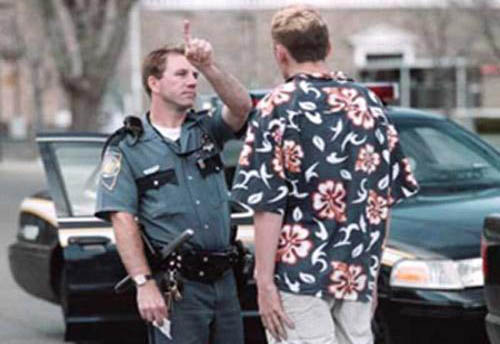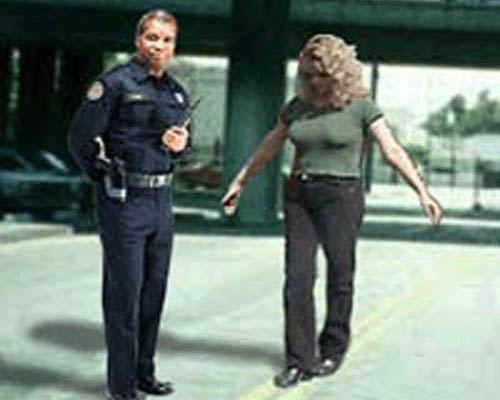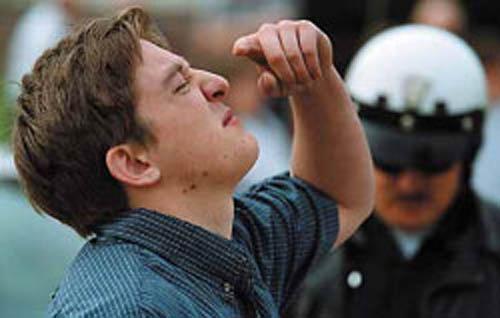FIELD SOBRIETY TESTS

HGN Test (Horizontal Gaze Nystagmus)
The Horizontal Gaze Nystagmus test is the first test that is supposed to be administered by the police officer. This is the "Pen Test" where a pen (or other stimulus) is passed in front of your face back and forth in order for the officer to determine if HGN is present in your eyes.
The basic premise is this: Your eyes have natural nystagmus in them. That is, a "shakyness" for lack of a better word. Without alcohol present, it is said that you cannot see the nystagmus. Once alcohol enters your system, the nystagmus can be seen by the naked eye.
Law enforcement claims that the HGN test is 88% accurate at determining if someone is 0.08 or above. . . HOWEVER,
There are MANY, MANY problems with that statement. For one, even if it is as accurate as claimed, the test must be performed exactly to specifications in order to not give a false reading! Many law enforcement officials have simply taken a 24 hour course (which less than 1/3 of covers HGN) in order to receive this training. They are not optometrist, opthomologists, or any true experts.
Additionally there are at least 47 types of Nystagmus. Yet the non M.D., O.D., or doctors of any kind purport to be able to tell the difference.
Only a skilled DWI attorney can point out to the jury the many faults of this Field Sobriety Test.

Walk & Turn Test
The walk and turn test is a "Divided Attention Task." What that means, is it is a test designed to have you do many different things at the same time. The thinking behind this, is that even if you are intoxicated, you can still perform tasks, one at a time. But when asked to do several things at a time, you cannot.
The police officer will as you to walk heel to toe 9 steps up and 9 steps back, counting out loud, while making a special type of turn. The officer is looking for 8 clues which would purport to show your intoxication.
This is a difficult test, even if you are not scared out of your mind, on the side of a busy highway. Again, this is a test that requires the officer to give the instructions properly, otherwise, what they see as mistakes can actually be you performing the test properly (as instructed). It is an extremely subjective test.
Additionally, although the police say they are looking at 8 clues, they are really judging you many, many more. The police claim that if you exhibit 2 of 8 clues, there is a 79% chance your BAC is over 0.08. HOWEVER, some of the clues, such as touching heel-to-toe, you can exhibit that clue on any of the 18 steps! So it really isn't just one clue, it's at least 18 that you can "exhibit" this sign of intoxication.
Only a skilled DWI attorney can point out to the jury the many faults of this Field Sobriety Test.

One Leg Stand Test
This is another one of the "Divided Attention Tasks" that you may be asked to perform. With the One Leg Stand (Not One Legged Stand) the officer will instruct you to stand on one leg, keeping the other leg more than 6 inches off the ground, and count to 30 (1-one thousand, 2-one thousand).
The officer is looking for 4 Clues, and if you exhibit any 2 of the 4, you are deemed to have failed this test. Law enforcement claims that if you show 2 clues, there is an 83% chance tat you are above a 0.08.
Only a skilled DWI attorney can point out to the jury the many faults of this Field Sobriety Test.
Portable Breath Test (PBT)
The officer may administer a Portable Breath Test ("PBT") on the scene. Most officers do not do this, but many of the Highway Troopers (DPS) will administer this. This is a handheld device that purports to show your BAC. Despite the claims, the results of this test ARE NOT EVEN ADMISSIBLE IN COURT! This is because of the unreliability of the devices. However, you need a good attorney to make the proper objections to keep this evidence out of the ears of the jury.

Other Tests
The officer may ask you to perform any number of other "non-standardized" tests. These can include finger dexterity tests, the "Rhomberg" balance test, or saying the alphabet.








